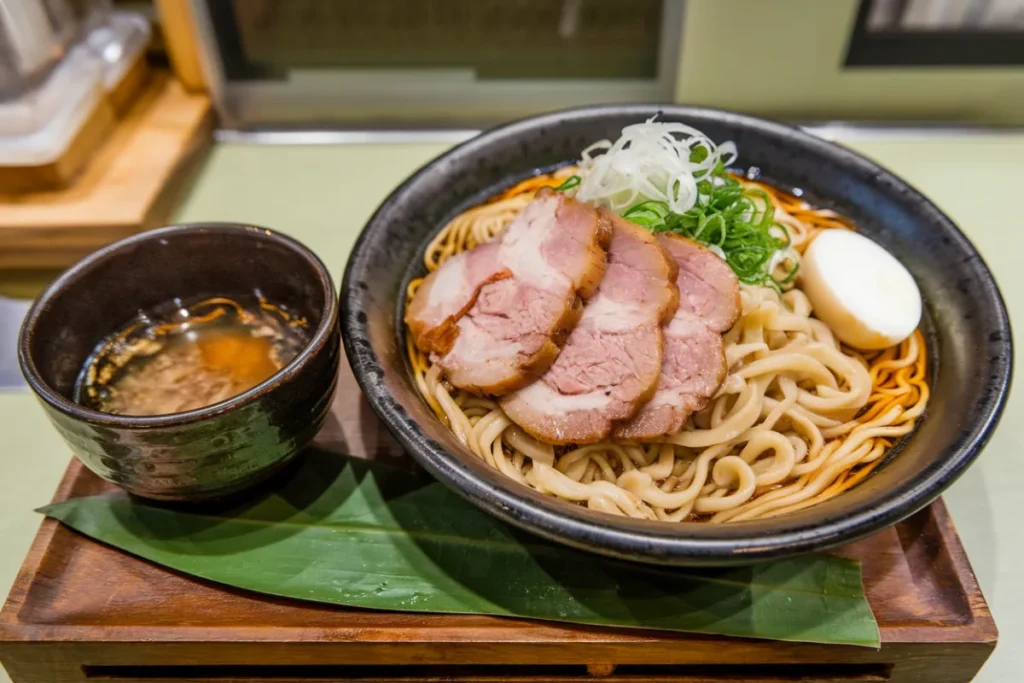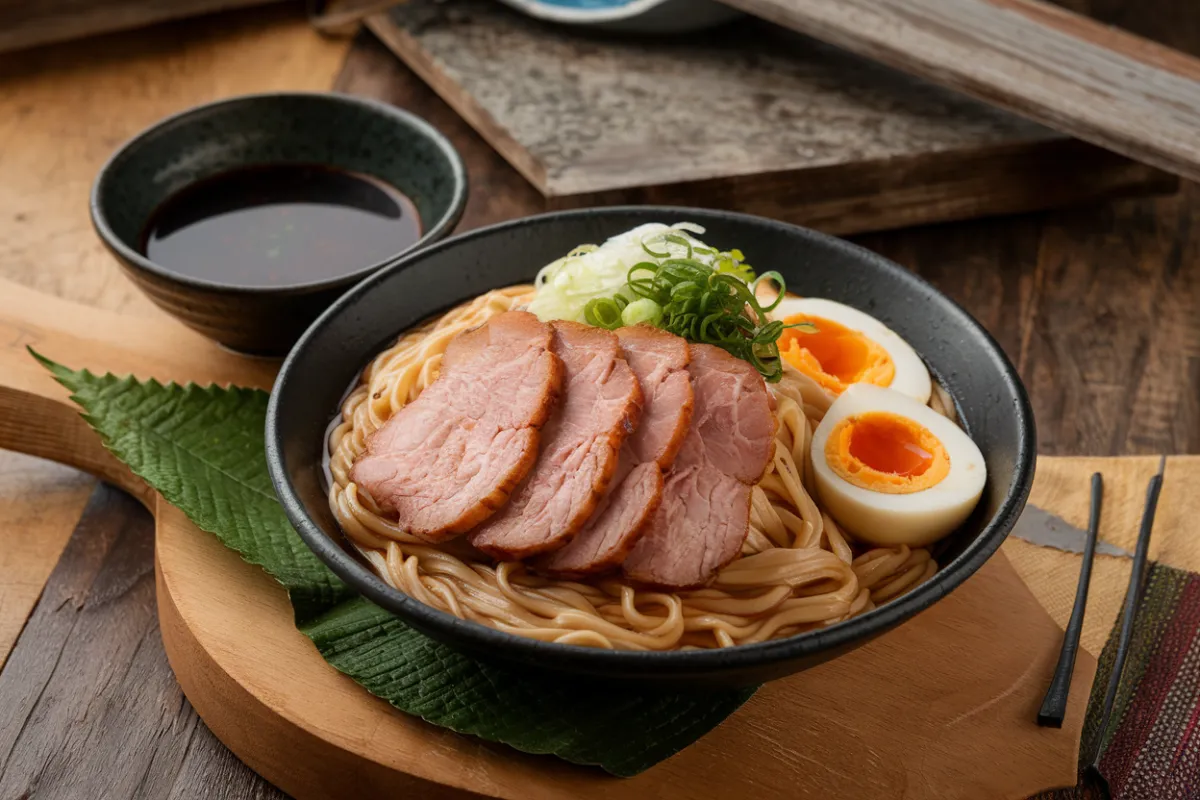Introduction to Tsukemen
Tsukemen offers more than just a dish; it provides a culinary experience deeply rooted in Japanese food culture. Unlike traditional ramen, where chefs serve noodles in a hot broth, tsukemen introduces a different approach by presenting the noodles and broth separately. This unique method raises an intriguing question: why do we dip tsukemen?
The answer lies in both practical and cultural factors that have made the dish so popular. In this article, we explore the history, preparation, and unique aspects of tsukemen. We will also delve into why this dipping method has become so beloved in Japan and around the world.
History of Tsukemen
The story of tsukemen began in the 1950s when Kazuo Yamagishi, a ramen pioneer, sought to create a new way to enjoy ramen noodles. At his Tokyo-based restaurant, Taishoken, Yamagishi experimented by separating the noodles from the broth. This method allowed him to create a more concentrated broth, which offered a richer and more intense flavor. Over time, tsukemen evolved, and today, it stands as a refreshing alternative to traditional ramen.
Tsukemen quickly gained popularity due to its unique approach, offering both versatility and a new flavor profile that traditional ramen couldn’t match. As Yamagishi’s creation gained traction, it spread across Japan and eventually reached international menus, becoming a staple in Japanese cuisine.
Learn more about the history of Tsukemen and how it revolutionized the way we think about ramen.
What is Tsukemen?
Tsukemen involves serving cold or room-temperature noodles separately from a hot, concentrated broth. Diners dip the noodles into the broth just before eating, which allows them to enjoy a unique taste and texture experience.
Key Components of Tsukemen:
- Noodles: Typically thicker and chewier than those used in traditional ramen.
- Broth: Intensely flavored, often made with dashi (a Japanese soup stock), pork, chicken, or seafood.
- Toppings: Common toppings include ramen eggs, chashu (braised pork), and menma (fermented bamboo shoots).
Unlike ramen, where the noodles soak in the broth and can become soggy, tsukemen allows the noodles to maintain their texture, providing a satisfying bite with each dip.
Discover a complete guide to Tsukemen to learn about its variations and modern interpretations.
Why Tsukemen is Dipped

Practical Reasons
One of the main reasons people dip tsukemen is its practical benefits. Serving the noodles and broth separately prevents the noodles from becoming too soft or overcooked, which can happen when they sit in hot broth for too long. By dipping, diners control how much broth each bite of noodles absorbs, ensuring that the texture stays perfect throughout the meal.
Flavor Enhancement
The broth in tsukemen offers a much more concentrated flavor than in regular ramen. This intensity is key to the dipping experience. When diners dip the noodles into the broth, they coat them with a rich, flavorful layer that delivers a powerful taste in each bite. The dipping process creates a balanced experience where the noodles and broth complement each other without overwhelming the palate.
Cultural Significance
Tsukemen deeply reflects Japanese dining culture. The separation of noodles and broth highlights the importance of texture and flavor in Japanese cuisine. Additionally, it offers a more interactive eating experience, allowing diners to customize each bite to their liking. This level of engagement with the food mirrors the broader Japanese culinary philosophy, where the process of eating holds as much significance as the food itself.
The Broth: Heart of Tsukemen
Ingredients in Tsukemen Broth
The broth in tsukemen is typically richer and more robust than in traditional ramen. Common ingredients include:
- Dashi: A Japanese soup stock made from kelp and bonito flakes.
- Pork bones: These provide a rich, creamy consistency.
- Soy sauce: It adds depth and umami to the broth.
- Miso: Some chefs use miso for an extra layer of flavor.
- Seafood: Shrimp or fish may be added for a unique taste.
Differences from Regular Ramen Broth
Unlike ramen, where the broth serves as a base, tsukemen broth coats the noodles with an intense burst of flavor. It’s often thicker, almost like a dipping sauce, which clings to the noodles more effectively.
Regional Variations in Broth Recipes
Across Japan, different regions have developed their own takes on tsukemen broth. For example:
- Tokyo: Known for a soy-based, fish-infused broth.
- Kyushu: Prefers a pork-based, tonkotsu-style broth.
- Hokkaido: Incorporates miso for a hearty, full-bodied flavor.
These variations offer a diverse range of tsukemen experiences, each bringing its unique taste.
Noodle Texture and Temperature
The Importance of Cold Noodles
Tsukemen noodles usually come cold or at room temperature. This contrast with the hot broth provides a refreshing balance, especially during warmer months. The cold noodles also maintain their firmness better, offering a satisfying chew with every bite.
How Noodle Texture Influences the Dipping Experience
The thicker, chewier noodles used in tsukemen withstand the dipping process well. They hold up in the rich broth, absorbing just enough flavor without becoming too soft.
Adjusting Noodle Temperature
While tsukemen is traditionally served with cold noodles, some variations allow for warm noodles, particularly in colder weather. This flexibility in temperature provides a different sensory experience and can change how the broth interacts with the noodles.
Toppings and Accompaniments
Toppings play a crucial role in enhancing the tsukemen experience. They add layers of flavor and texture that complement the noodles and broth.
Common Toppings:
- Ramen Eggs: Soft-boiled eggs with a marinated yolk.
- Chashu: Tender slices of braised pork.
- Menma: Fermented bamboo shoots add a slight crunch.
- Nori: Dried seaweed sheets bring a touch of umami.
- Scallions: Fresh, chopped green onions add brightness.
These toppings can be added to the noodles before dipping or enjoyed separately, allowing for a customizable eating experience.
How to Eat Tsukemen Properly
Traditional Japanese Etiquette
Eating tsukemen involves certain customs that enhance the dining experience:
- Dip and Eat: Only dip a small portion of noodles at a time to avoid over-soaking.
- Slurping: Slurping noodles is considered polite and helps aerate the broth to bring out its flavors.
- Sip the Broth: After finishing the noodles, diners often drink the remaining broth, sometimes diluted with hot water.
Tips for Enhancing the Flavor Through Dipping Techniques
To get the most out of your tsukemen:
- Stir the broth to mix in the toppings before dipping.
- Vary the dipping depth for different flavor intensities.
- Add condiments like sesame seeds, chili oil, or vinegar to the broth for a personalized touch.
Customizing Your Dipping Experience
Many restaurants offer options to modify your tsukemen experience:
- Extra noodles: A great choice for those who want a more substantial meal.
- Hot water addition: Diluting the broth toward the end provides a lighter finish.
- Different toppings: Experiment with seasonal or regional toppings for variety.
Tsukemen in Modern Japanese Cuisine
The Rise of Tsukemen in Japan
Since its creation, tsukemen has become a staple in Japanese cuisine. Its unique approach to noodle eating has attracted a loyal following, both in Japan and internationally. The dish’s versatility has allowed chefs to innovate, creating new variations and fusion dishes that cater to diverse tastes.
Tsukemen’s Influence on Modern Ramen Culture
Tsukemen has significantly influenced modern ramen culture. Its success has inspired other ramen innovations, leading to a broader range of ramen dishes that explore new textures and flavors. The concept of dipping noodles has also been adopted by other noodle dishes, further cementing tsukemen‘s place in Japanese culinary history.
Tsukemen in Popular Culture
Tsukemen has also made appearances in popular culture, from manga and anime to television shows, highlighting its importance as more than just a meal but a cultural icon. Its growing presence in food festivals and events around the world continues to spread its popularity.
Variations of Tsukemen
Regional Variations in Japan
Different regions in Japan have put their own spin on tsukemen:
- Tokyo: Soy-based, fish-infused broths are common.
- Kyushu: Rich, pork-based tonkotsu broth is popular.
- Hokkaido: Miso-based broths offer a hearty, warming option.
These variations provide a taste of local flavors and ingredients, showcasing the diversity within Japanese cuisine.
Fusion Tsukemen in International Cuisine
As tsukemen has gained global recognition, chefs worldwide have begun incorporating it into their menus, often blending it with local flavors:
- Spicy Korean Tsukemen: Featuring kimchi and gochujang in the broth.
- Italian Tsukemen: Using a tomato-based dipping sauce.
- Vegetarian and Vegan Tsukemen: Broths made from mushrooms, miso, or vegetables provide an alternative for non-meat eaters.
Vegetarian and Vegan Tsukemen Options
With the growing demand for vegetarian and vegan options, many restaurants now offer tsukemen with plant-based broths and toppings. These variations maintain the rich flavors and textures of traditional tsukemen while catering to different dietary needs.
Health Aspects of Tsukemen
Nutritional Benefits and Considerations
Tsukemen offers a balanced meal with its combination of carbohydrates (noodles), proteins (broth and toppings), and fats (broth). However, due to the richness of the broth, it can be high in sodium and calories. Moderation is key to enjoying tsukemen as part of a healthy diet.
Comparing Tsukemen with Other Ramen Types
Compared to traditional ramen, tsukemen may be a slightly healthier option due to the controlled portioning of broth consumption. Since you dip the noodles rather than soaking them, you can regulate the amount of broth (and therefore sodium) you consume.
Frequently Asked Questions
What is the difference between Why is Tsukemen Dipped?
Tsukemen is a type of ramen where the noodles are served separately from the broth, which is thicker and more concentrated. This contrasts with traditional ramen, where noodles are served in a hot, often lighter, broth.
Why are Tsukemen noodles served cold?
Cold noodles are essential to the tsukemen experience because they retain their firmness and provide a refreshing contrast to the hot broth. The cold temperature also prevents the noodles from becoming overcooked or soggy.
Can Tsukemen be eaten with hot noodles?
Yes, while traditionally served cold, tsukemen can also be enjoyed with warm noodles, especially during colder months. This variation offers a different texture and experience.
Is Tsukemen healthier than regular Ramen?
Tsukemen can be healthier if consumed in moderation, as it allows for control over how much broth is consumed. The concentrated broth in tsukemen may contain more sodium, so it’s important to balance it with other components of the meal.
Conclusion
Tsukemen offers a unique and engaging way to enjoy noodles, combining the best of Japanese culinary traditions with modern innovations. Its origins, deeply rooted in Japan’s post-war history, and its rise to global fame demonstrate its lasting appeal. By understanding why tsukemen is dipped and exploring its many variations, you can appreciate this dish as more than just a meal—it’s an experience that reflects the artistry and creativity of Japanese cuisine

